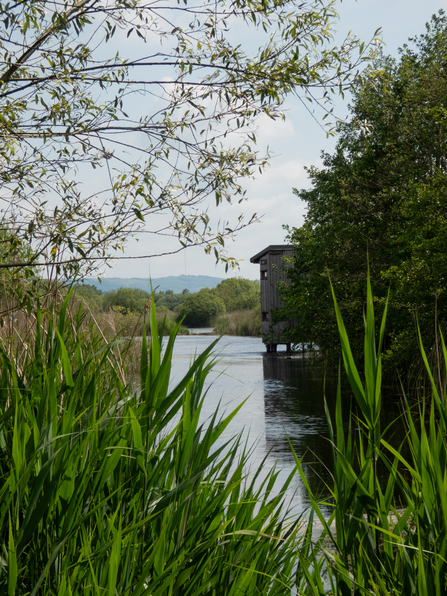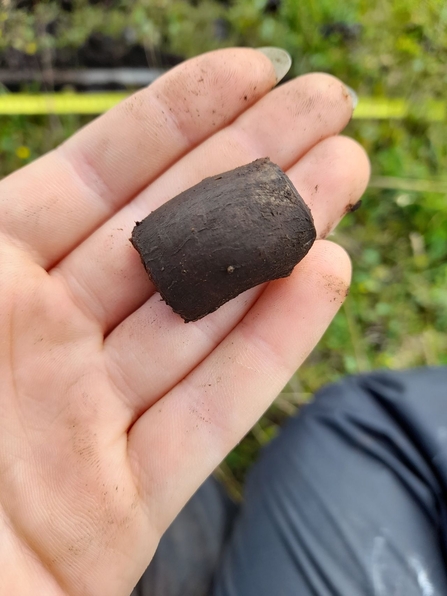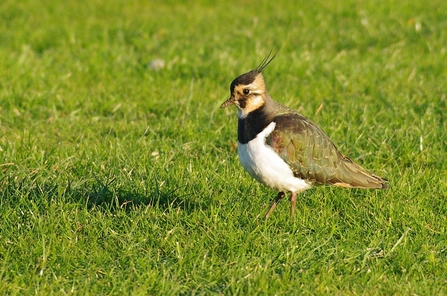The peatlands have been used for millennia, with Neolithic people using reeds as thatch and hunting fish and wildfowl and the Romans burning peat at the salt works. In more recent centuries, the land has been drained and reclaimed for agriculture, peat cutting for domestic fuel and more recently industrial extraction for use in industries like horticulture. Despite this, there is estimated to be around 11 million tonnes of carbon stored in Somerset’s lowland peat, a vital climate asset.
Restoring Westhay Moor National Nature Reserve

Image: Emily Weatherburn
But what is a peatland? Peatlands are a kind of wetland. When plants grow, they take carbon out of the atmosphere to build new plant tissue. On a peatland when plants die, they fall into waterlogged conditions which stalls the decay process. As layers of dead plant material and the carbon they contain build up, peat is formed, but in a peat bog, the process is incredibly slow – at a rate of just 1mm a year. At Westhay Moor, there are still 2-3 metres of peat remaining which are between 6500 and 4500 years old, but it is thought the peat there could once have been 8 metres deep.
However, drainage and peat extraction allow the decay processes to restart. In drying the peat out, carbon that is thousands of years old is released back to the atmosphere. This happens even if the peat is capped by grass. Once drained, peat wastage happens, meaning that land height can drop, and the peat no longer holds onto water as it once did, which can make flooding worse.

Image: Jemima Western
In 1970, Somerset Wildlife Trust bought ‘The Mire’ at Westhay Moor. It is one of the largest remnants of lowland acid raised bog in the south west — a precious but struggling remnant of peatland habitat that has been hand dug for fuel with a network of drains that increase the flow of water out of what would have been a healthy wetland. Scars from decades past that are still visible on aerial images today.
Over the past five decades, the Trust has done much to stop the peat drying out. It has acquired and been gifted more land around the mire to act as a watery buffer.
Today, the reserve also includes several former industrial peat voids where the peat has been extracted down to the underlying clay. These have been painstakingly restored over many years to the mosaic of reedbed and open water habitat which provide important habitat for breeding wetland species like the bittern and overwintering birds.
But where peat remains at Westhay Moor there are several indicators that the habitat is still drying out – birch, scrub and bracken are present which the Trust’s Reserves Team and volunteers battle to clear each year and are signs that all is not well beneath the surface. In some small areas, things are better: open habitats have successfully been maintained and low-growing peat bog species like sphagnum mosses, round-leaved sundew occur alongside micro plume moths and the large marsh grasshopper, but these only occur in isolated pockets.
Where bracken and bramble have encroached, they have dried out conditions further, allowing larger scrub and trees to grow which further exacerbate the situation. Trees on lowland raised bog are damaging for two reasons. First, they take water up out of the peatland, transpiring it to the atmosphere. Second the leafy canopy acts as an umbrella stopping rainfall from reaching the surface of the peat.
Over the years, Somerset Wildlife Trust has done work to slow the flow of water in the peat on the reserve, but in August 2023, it embarked on a new phase in the rehabilitation of Westhay Moor with project work funded by Nature for Climate Peatland Grant Scheme and the Valencia Communities Fund, via the Landfill Communities Fund.
There are three main phases to the work:
- The first phase is vegetation management, where non-peatland species like trees and bracken are removed to give the mosses and more specialist open-habitat species a fighting chance. This also ensures that all potential drainage features that were hidden by taller vegetation are discovered for remediation.
- Second, comes the groundworks, which aim to slow the flow of water both within and on top of the peat. As a type of wetland, peatland hydrology (water level, volume, and movement) both inside and on top of the peat is key. So, a restoration technique called deep trench cell bunding has been used. This technique involves making a network of backfilled trenches using compacted peat to seal up water loss features beneath the surface, importantly keeping the water in.
On the surface, low bunds are made to stop the rainwater running off into ditches, instead encouraging it to filter down into the peat. The wetter surface conditions allow bog species to become established and make it too wet for bracken and brambles.
This technique has been honed over the last few decades in the North of England and is only the second time this approach has been applied in lowland Somerset — the first being at Natural England’s Shapwick Heath National Nature Reserve.
- For the third phase, specialist peatland plants are being used to give the restoration works the best possible start. Sphagnum mosses are an incredible group of mosses, they can hold up to 20 times their own weight in water and help to regulate pH in waterlogged environments. Forging conditions best suited to their own survival and that of the peatland.

Image: Gillian Day
This project is a big leap forward for the rehabilitation of the remaining peat at Westhay Moor and in truth, it will take many years and potentially a few tweaks to bring our precious peatland back from the brink.
But the early signs show promise. The second half of 2023 was undeniably wet, but it is already clear that the areas that have been cleared and bunded on the reserve are holding rainwater very well, and bog species like the round-leaved sundew are appearing in areas that were previously dominated by tall grasses and bracken. There have also been ground nesting birds like lapwing taking advantage of the newly created open habitat.
Through our monitoring network and the work of our volunteers, we hope that more positive news will follow in the coming months and years as the groundwater levels rise, securing the carbon and providing a better, wetter habitat for rare peatland species.
Somerset is one of the last two counties in England where commercial peat extraction is still taking place. The government’s promised ban on bagged peat compost in 2024 has yet to make it into law, so to keep the peat in a bog, not a bag, make sure to buy peat-free compost and bedding plants. You can also keep an eye out for products that may be produced with ‘hidden peat’ such as potted herbs and mushrooms. Find out more about protecting our precious peatlands.

